Hey there, fellow EV enthusiasts and industry titans!
Let’s talk about the elephant in the room – or should I say, the plug in the room? We’re all hyped about the electric vehicle revolution, right? Shiny new cars, lower emissions, a greener future… it’s all incredibly exciting. But there’s a HUGE piece of this puzzle that could make or break the whole thing: charging infrastructure.
Think about it: you wouldn’t buy a gas-guzzler without easy access to gas stations, would you? The same principle applies to EVs. Right now, the charging landscape is… well, a bit patchy. Some areas are a charging utopia, others are a desolate wasteland of range anxiety. We’ve got everything from super-fast chargers promising a full tank in minutes (almost!) to those agonizingly slow Level 2 chargers that leave you feeling like you’re charging a Tamagotchi.
This isn’t just a minor inconvenience; it’s the make-or-break factor for mass EV adoption. If we don’t get the charging infrastructure right, we’re looking at a stalled revolution, a whole lotta frustrated drivers, and potentially a massive financial setback for the industry. (Yikes!)
So, is the current situation going to crush the EV dream, or will smart planning and clever investment crown it as the future of transportation? That’s what we’re diving into today. Whether you’re a seasoned charging infrastructure pro or a business leader wrestling with the complexities of EV manufacturing, this post is for you. Let’s unpack the challenges, explore the solutions, and figure out how we can collectively power up the future!
Hey there, future charging infrastructure mogul! Let’s dive into the exciting (and sometimes bumpy) world of EV charging. I’ve broken down some key trends, showing you both the sweet spots and the potential potholes.

Positive Trends – Gettin’ Your Charge On!
- Government Incentives & Regulations: Governments worldwide are heavily investing in charging infrastructure. Think tax credits, subsidies for installing chargers, and even mandates for certain numbers of public chargers. This is HUGE for the market. Companies like ChargePoint are already leveraging this by expanding rapidly into regions with supportive policies.
- Increased EV Adoption: Duh, right? More electric vehicles mean more need for chargers. This isn’t just about cars, either; e-bikes, e-scooters, and even electric buses are driving demand. Companies need to think beyond just car charging.
- Technological Advancements: Faster charging speeds (hello, 800kW!), smart charging management, and better battery tech are all making the whole experience way more appealing. Companies that can stay ahead of the curve on tech are gonna win big. Think about companies integrating AI to optimize charging networks.
- Private Sector Investment: Venture capitalists and big corporations are throwing money at this sector. This means more innovation, more competition, and more opportunities for startups and established players alike. Tesla’s Supercharger network shows the power of vertical integration, but there’s room for everyone!
Adverse Trends – Navigating the Speed Bumps
- Interoperability Challenges: Not all chargers are created equal. Different standards and payment systems can be a nightmare for drivers. We need standardization to avoid a fragmented market; otherwise, consumers will be frustrated.
- Grid Capacity Constraints: A massive increase in EV charging puts pressure on existing power grids. Upgrading infrastructure is expensive and time-consuming. This could slow down growth unless we plan strategically.
- High Installation Costs: Setting up charging stations ain’t cheap. Land acquisition, grid connection fees, and equipment costs can be substantial, especially in urban areas. This can be a barrier to entry for smaller companies.
- Charging Station Maintenance: Keeping charging stations up and running requires regular maintenance and repairs. Downtime means lost revenue and frustrated customers. Companies need robust maintenance strategies.
Actionable Insights – Your Winning Playbook
- Embrace Standardization: Advocate for and support interoperable charging standards. It’s better for everyone!
- Strategic Partnerships: Collaborate with utilities, real estate developers, and even competitors to share infrastructure costs and expand coverage.
- Smart Grid Integration: Develop charging solutions that work with the grid, not against it. Think smart charging algorithms that manage peak demand.
- Data-Driven Optimization: Use data analytics to understand charging patterns, optimize network performance, and target high-demand locations.
- Focus on Customer Experience: Make the charging experience as seamless and convenient as possible. Reliable chargers and easy payment are key.
- Government Lobbying: Engage with policymakers to influence regulations and secure funding opportunities.
So, there you have it! The charging infrastructure market is ripe with opportunities, but it’s also a competitive landscape. By understanding these trends and implementing the right strategies, you can position your business for success. Now go out there and electrify the world!
Healthcare: Hospitals are using charging stations to power electric vehicles for their mobile medical units. This ensures ambulances and other emergency response vehicles can operate efficiently without range anxiety, especially crucial in rural areas. Think about the potential for faster response times and reduced downtime!
Technology: Large tech companies like Google and Facebook are installing extensive charging networks at their campuses to encourage employee adoption of EVs. This improves their corporate sustainability image and offers a perk to attract and retain talent. It’s a win-win – happy employees, greener company.
Automotives: Car manufacturers themselves are investing heavily in charging infrastructure. This isn’t just about selling cars; it’s about building an ecosystem. They’re strategically placing fast-charging stations along major highways to support long-distance travel in their EVs and showcase the vehicles’ capabilities. You need to think about where your customers will be charging, not just if they will.
Manufacturing: Factories are increasingly using charging infrastructure for their fleets of electric forklifts and other material-handling equipment. This reduces reliance on fossil fuels and minimizes emissions within the facility. Plus, the reduced maintenance on electric equipment can save you money in the long run. Have you considered the total cost of ownership when comparing electric and gas-powered fleets?
Retail & Logistics: Delivery companies like Amazon and UPS are integrating charging stations into their warehouses and distribution centers. This is essential for powering their growing fleets of electric delivery vans. This is a huge opportunity, and a necessary investment, given the increasing demand for quick delivery. Get ahead of the curve.
Real Estate: Developers are including charging stations in new apartment complexes and commercial buildings to cater to the growing demand for EV charging. It’s no longer a luxury, it’s a selling point for tenants and customers. Consider this – how much would you pay extra for guaranteed, easy charging on-site?
Government: Many municipalities are installing public charging stations in public parking lots and along roadsides. This is driven by environmental goals and an effort to support the transition to electric vehicles. This shows a huge public shift toward EV adoption, providing a massive market for your charging solutions.
Remember, strategically placing charging infrastructure isn’t just about the technology; it’s about understanding your target market and meeting their needs. This is where you can truly make a difference, and reap the rewards.
Strategic Partnerships & Joint Ventures:
Several charging companies are forging alliances with EV manufacturers (OEMs). For example, imagine a charging network provider teaming up with a major automaker to offer bundled charging packages with new vehicle purchases. This ensures a ready customer base for the charging network and provides a compelling value proposition for car buyers. It’s a win-win, right? This strategy leverages the strengths of each partner, accelerating market penetration for both.
Expansion into New Geographic Markets:
Rapid international expansion is another key strategy. Think of a charging company aggressively moving into underserved regions, both domestically and abroad. This could involve setting up charging hubs in areas lacking infrastructure, focusing on high-traffic locations like shopping malls or tourist hotspots. This requires careful market analysis, regulatory compliance, and strong local partnerships. Don’t underestimate the importance of understanding local energy grids and regulations.
Software & Data Analytics Focus:
Companies are investing heavily in sophisticated software platforms to manage their networks efficiently. These platforms use real-time data to optimize charging station operations, predict energy demand, and enhance the user experience through features like seamless payment processing and intelligent routing. This data-driven approach is crucial for optimizing network performance and profitability. This is where you, the charging infrastructure professional, can really shine, leveraging these tools for maximum impact.
Subscription Models & Bundled Services:
Flexible subscription-based charging plans are becoming increasingly popular. This contrasts with older, per-use models. These plans can offer tiered access to different levels of charging speed and service features, providing various pricing options for diverse consumer needs. Bundling services, such as vehicle maintenance or insurance, alongside charging subscriptions, increases customer loyalty and average revenue per user (ARPU).
Acquisitions of Smaller Players:
Inorganic growth through acquisitions is another prominent strategy. Imagine a larger charging network company buying out a smaller competitor with a strong presence in a specific region or niche market. This accelerates market consolidation and expands the larger company’s reach quickly. This is particularly relevant for reaching rural areas or specialized segments like commercial fleets.
Investment in Ultra-Fast Charging Technology:
The race is on to provide faster charging solutions. Companies are investing heavily in research and development of ultra-fast charging technologies to reduce charging times significantly. This attracts customers seeking quicker turnaround times and is especially crucial for long-distance travel. You, the EV manufacturing leader, need to understand this trend and ensure your vehicles are compatible with these faster charging speeds.

Outlook & Summary: Charging Up the Future (or Not)
Hey everyone, so we’ve just explored the wild, wild west that is EV charging infrastructure, right? The big question: will it be the hero or the villain in our electric vehicle fairytale?
Over the next 5-10 years? Buckle up, buttercup! We’re gonna see some serious changes. Think massive investment in fast chargers, a huge push for standardization (finally!), and probably some pretty creative solutions to the “range anxiety” problem. We’ll also see some players rise to the top and, let’s be honest, some fall flat on their faces. It’s a gold rush mentality out there.
The thing is, charging infrastructure isn’t just supporting the EV revolution; it is the revolution. It’s the unsung hero (or potential villain) – without it, even the sleekest, most innovative EV is just a really expensive, immobile paperweight. Think of it this way: EV manufacturing is building the awesome cars, but the charging infrastructure is building the roads they’ll drive on. One’s useless without the other.
My main takeaway? This isn’t just about building chargers; it’s about building a network. It’s about smart grids, seamless payment systems, and user-friendly interfaces. It’s about making the whole EV experience – from purchase to daily driving – a breeze. Get that wrong, and you’re gonna see a lot of frustrated EV owners. Get it right, and you’re looking at a massive market poised for exponential growth.
So, here’s the million-dollar question: Are you ready to play a key role in building the future of EV charging – or will you get left in the dust?





